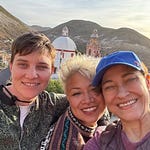After six months of not traveling—of being tethered to the rhythms of hospitals and healing—I said yes to attending the wedding of two dear friends, held in Real de Catorce. I wasn’t entirely certain my body was ready. So I made a plan, modest but hopeful, and took the first step.
I found myself in the heart of San Luis Potosí—a city steeped in history, dusted with light, and animated by the kind of joy that spills out into the streets. My plan was simple: give myself a few days to land gently, to reacquaint with the rhythm of movement, before undertaking the onward journey which would be more arduous—miles of timeworn cobblestones leading us into the embrace of the mountains, their elevation a quiet test for lungs still mending from surgery. Even the act of being in an airport again—once the backdrop of my life—felt both foreign and intimate. A choreography of thresholds, each one a quiet reminder: what was once easy is now hard-won.
The next day, feeling unexpectedly buoyant, I wandered the city’s labyrinthine streets—through churches, sunlit squares, bustling markets, quiet cafés, murals blooming across old stone walls, archways draped in bougainvillea. I found myself, by late afternoon, at a former prison—its walls once meant to contain now opening into light—transformed into a sanctuary of culture and expression. The Centro de las Artes, with its open-air courtyards, stone archways, and scattered sculptures, now houses the Museum of Leonora Carrington, where her surreal, deeply spiritual works invited me into a dreamscape of myth and magic.
As dusk fell, guests arrived for a Friday night concert. Under an open sky, the air filled with the beat of music, and the flicker of candlelight where guests painted at communal tables, drinks in hand. Around every corner something was unfolding — an art exhibition, a fashion show, an exercise class, tables offering handmade art and local snacks, small stations of beauty and expression inviting people to create, to move, to be. It felt like a quiet revelry—a celebration of imagination, expression, and the serendipity of landing in the right place at the right time.
With my limited Spanish, I turned to my translation app to help me ask about some nearby waterfalls I had heard about. In a simple, generous act, a woman reached out to her network, handed me her phone, and with that gesture, the universe conspired to guide me onward.
Tamul: A Visitation in Water
At dawn the next morning, I was whisked away on an all-day adventure, leaving behind San Luis Potosi’s dry highlands dotted with cacti and shrub and descending into the lush, verdant jungles of the Huasteca. Our journey led us to a riverside trail, where we began our hike down to the turquoise waters that feed the breathtaking Tamul Waterfall. We rowed for four kilometers in a long wooden canoe through a canyon, where cliffs rose like ancient cathedral walls—vast, solemn, and utterly alive.
Tamul revealed itself gradually, a veiled colossus. Over 300 feet of water thundered down in luminous sheets, the spray catching the sun like fragments of light. It was not merely a waterfall—it was a force, a presence. It felt less like a destination and more like a visitation. The water spoke in languages older than speech.
I chose to swim part of the way back through the rapids—exhilarating, shocking, delicious. After I rejoined the canoe, we stepped out once more to hike up beyond the waterbed into the hush of a mountain cave. There, I plunged into even colder mountain water, surrounded by ancient stalagmites and stalactites—teeth of the earth shaped by time.
Back in the canoe, we squealed as we were drenched beneath more cascades, our voices mingling with the rush and tumble of water. There was a tradition: whenever another canoe passed, a water fight would erupt—oars and half-bottles filled with water flung joyfully, each crew trying to soak the other as thoroughly as possible. Often the approaching canoe would shout out a war cry as a kind of watery challenge. When we shouted our own cry—¡Paz y amor! (Peace and love!)—we were met with gleeful retaliation and ended up more drenched than ever.
There I was—soaked, breathless, weightless—swept up in joy and motion. I surrendered to the current. I trusted the flow. My body sang with life. And somehow, impossibly, this came just weeks after I was grounded in that hospital room, weakened and sick, wondering if I’d ever return to a life this vivid.
The Road to the Sacred
The next morning, my friend—the reason for this journey—picked me up in San Luis Potosí. Together, we made our way toward Real de Catorce, a town Mexicans speak of in hushed, reverent tones as a ciudad mágica. The final hour of the drive unfolded across cobblestones weathered by centuries and through mountain roads carved by hand, narrow and winding as a pilgrim’s path.
The last passage was through a one-lane tunnel, hewn from stone over a century ago. Riding through it felt like traveling through the belly of time—a birth canal of sorts. And when we emerged on the other side, something in the air shifted. The light bent differently. The silence felt sacred. Real de Catorce was revealing itself.
A former silver mining town now home to seekers, mystics, and Wixárika elders, Real de Catorce is perched high in the Sierra Madre, its bones made of stone and wind. There is something otherworldly here—the kind of magic that doesn’t try to impress but simply is. A kind of stillness that doesn’t demand silence, only presence. I’ll be here for a few days leading up to the wedding, which will unfold in the Wixárika tradition—an all-night ceremony led by mara’akame followed a day later by a pilgrimage up the sacred mountain of Quemado. Until then, I’m here to help, to listen, to be part of something ancient and intimate and alive.
What We’re Fighting For
We are living through unbearable times. Each day brings a fresh wave of violence, injustice, and unraveling. It’s easy—natural even—to go numb. To shut down. Or to believe we must choose between action and awe. Between showing up for the world’s pain and opening ourselves to its beauty.
But we need both. Fierce, unrelenting action—and deep, devotional love for this world. Especially now. Not the abstract, performative kind. But the messy, embodied kind. The kind that pulls you into a cold river before you have time to think. That reminds you your body still breathes. That lets you laugh with strangers whose names you may never know. That opens you—delicately, dangerously—to beauty. Not as a luxury or escape, but as fuel.
Living with terminal illness, I have to choose how I spend what’s left of my time. But truly, isn’t that the quiet truth for all of us?
These days have reminded me: there is still so much to love. So much to protect. And maybe the most radical way to stay in the fight is to remember what we’re fighting for—not only what we’re fighting against.
Let it be beauty. Let it be joy. Let it be wild water, and trust, and love, and adventure.
And yet, even amid beauty, heartbreak finds its way in.
Just days ago, a powerful earthquake struck Myanmar—a place where so many of my stories, heartbreaks, and hopes have lived. Not long ago, I sat in the ILF office in Mandalay, a space once filled with purpose, now fractured and abandoned. Miraculously, all 42 members of the ILF team—lawyers, social workers, and staff—are safe. Others were not so lucky. And almost everyone’s homes are damaged, and food, water, and electricity are scarce.
And yet, even in the midst of this crisis, they continue doing what they always do: showing up. Reaching clients. Visiting detention centers. Defending children. Fighting for justice in the face of near-impossible odds. They are some of the fiercest, most committed advocates I know.
If you’ve followed my writing on Myanmar or simply feel moved to offer support, you can donate to the International Legal Foundation here. All donations received from today forward will support the ILF’s emergency response efforts in Myanmar.
Let’s hold each other close across borders and broken ground. Let us keep loving the world fiercely—even, and especially, when it trembles.








